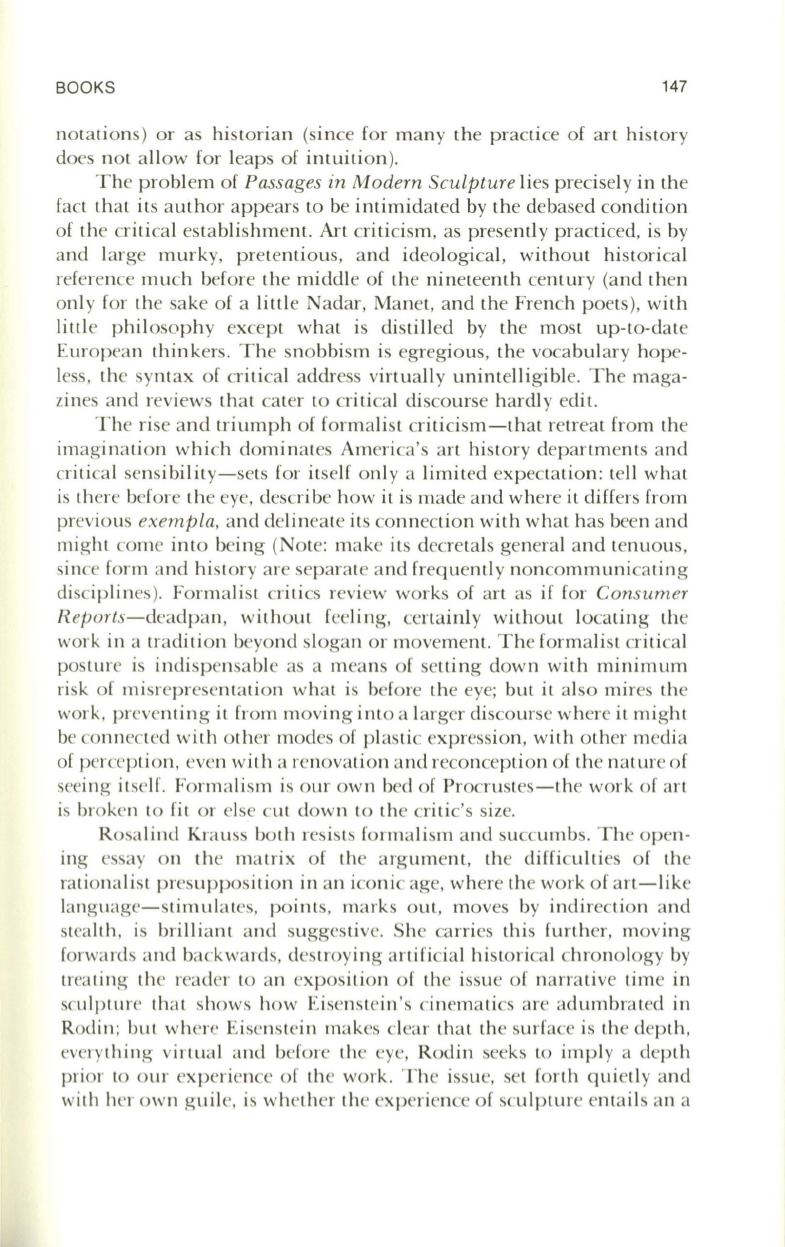
BOOKS
147
notations) or as hi sLOri an (s ince for many the practi ce of an hi story
does not all ow for leaps of il1luition ).
T he probl em of
Passages in Modern Sculpt ure
li es precisely in the
fact that its author appears LO be il1limida ted by the debased conditi on
of the criti ca l es ta blishment. Art criti cism, as presentl y practiced, is by
and large murky, pretenti o us, and ideological, without hisLOrica l
reference much before the middl e of the nineteel1lh century (and then
onl y for the sake of a littl e Nadar, Manet, and the French poets), with
lilli e phil osophy except wha t is distill ed by the most up-to-da te
European thinkers. T he sno bbism is egregio us, the voca bul ary hope–
less, the sY l1lax of critical address virtuall y unil1lelli gible. T he maga–
zines and rev iews tha t cater to criti cal di scourse hardl y edi t.
T he rise and tr iumph of formalist criti cism-that retreat from the
imagina ti o n whi ch domina tes Ameri ca's art history depanments and
criti ca l sensibility- sets for itself onl y a limited expecta tion : tell wha t
is there before the eye, describe how it is made and where it differs from
previo us
exempla,
and delineate its connection with what has been and
might come into being (Note: ma ke its decretals general and tenuous,
since form and hi story are separate a nd frequentl y noncommuni ca tin g
discip lines). Formalist critics rev iew works of art as if for
Consumer
Reports-deadpan ,
without feeling, certainl y without locating the
work in a traditi o n beyond slogan o r movement. The forma list criti cal
pos tu re is indi spensa bl e as a means of setting down with minimum
risk of mi srepresel1la ti on wha t is before the eye; but it also mires the
wor k, prevel1ling it from moving il1lo a larger di scourse where it mi ght
be connected with o ther modes of pl asti c expression, with o ther media
of percepti on, even with a renovati on a nd reconception of the na ture o f
seeing itself. Fo rmali sm is our own bed of Procrustes -the work of art
is broken to fit or else cut down to the criti c's size.
Rosa lind Kra uss bo th res ists fo rma lism and succumbs. The open–
ing essay o n the ma tri x of the a rgument, the difficulti es of the
ra ti ona li st p res u p pos ition in an iconic age, where the work o f art-like
lang uage- stimula tes, po ints, ma rks out, moves by indirection and
stea lth, is brilliant and sugges tive. She ca rries thi s further, mov ing
forwa rds a nd backwa rd s, destroy in g a rtificial histori ca l ch rono logy by
trea ting the reader to an expos itio n o f the issue o f na rra tive time in
sculp ture tha t shows how Eisenstein 's cinema tics a re adumbra ted in
Rodin ; but where Eisenstein ma kes clea r that the surface is the depth,
every thing virtua l and before the eye, Rodin seeks to impl y a depth
pr ior to o u r experience o f the work . T he issue, set forth quietl y and
with her own g uil e, is whether the experi ence of sculpture enta il s an a


